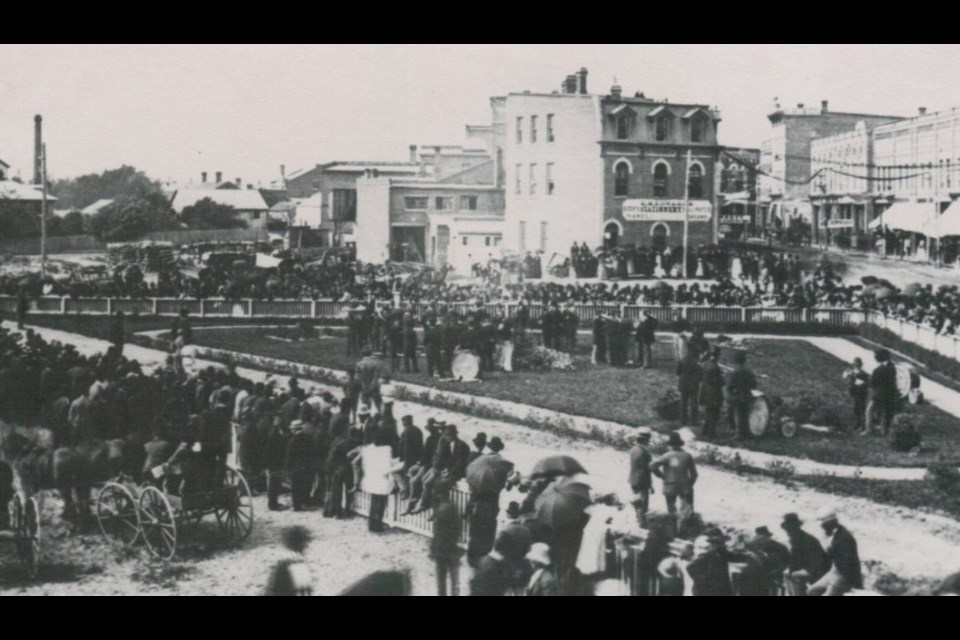Two weeks ago, Barrie Winterfest was in full swing. The weather was unprecedented and the crowds were large and energized.
Theatre by the Bay had organized a series of street performances, part play and part local history walking tour. As I waited at the starting point on the western edge of Meridian Place, I noticed a number of people were coming to the spot with the sole purpose of having a look at the ‘hole in the ground.’
The thing that most fascinated the observers was a row of windows on the south side of the stone basement of the recently demolished building. These windows, likely buried for more than a century, were below street level. Bricks added to the exterior had long obscured any view of the waterfront.
I chatted with a few of the curious, and gave them a few quick details of the late building’s history. Meanwhile, my email inbox began to fill with queries about the now-exposed foundation of the structure as well. It would appear a story on the subject is in order.
The series of Victorian-era business buildings that stand between Meridian Place and Five Points, on the south side of Dunlop Street East, are part of the Glebe Block. These brick structures were built to replace the original wooden block that fell to a destructive fire in 1871.
Over the years, subsequent blazes have further altered the look of the block.
Where most of the old buildings along Dunlop Street are of an 1870s vintage, their foundation can be much older, perhaps dating back to the 1830s or 1840s, when the first wooden building was erected on the site.
The building that once stood above this so-called hole in the ground fooled me for years. It was the Bank of Montreal as long as I could remember, and its modern facade led me to believe it was of mid-20th-century construction.
In 2017, I learned otherwise. As the building was stripped back to bricks, it suddenly looked much older. The owner at the time had me do a little research for him, and I was quite surprised at what I found.
In the beginning, starting about 1848, a rather large hotel stood on the spot. Brewer’s Hotel had a wraparound porch, and upper balconies that offered wonderful views of Kempenfelt Bay. By 1871, the hotel had gone through several hands, and an extensive renovation, and was then managed by Daniel Faragher.
On June 24, 1871, a fire destroyed the entire block. Faragher’s Hotel was the last building to fall that day.
The ruined block was soon rebuilt, but the spot where Faragher’s Hotel once stood remained empty for another 20 years. That changed in 1891, when newspaperman Nathaniel King decided this would be an excellent location for a music hall for the people, and for a better newspaper office for himself.
King’s Music Hall had a brief heyday. When it opened, it was a welcome change from the smaller early venues, which included the town hall. However, with the arrival of the Grand Opera House on Collier Street in 1896, King’s Music Hall became less relevant.
By 1909, the entertainment landscape had changed, and moving pictures were slowly replacing live performances. That autumn, the Guthrie family, of Peterborough, were leasing space in the music hall to operate their business, Crystal Moving Pictures.
In November 1909, the hall was deliberately set on fire by the lessees as part of an insurance scam.
The building was partially destroyed and required extensive repairs. It would seem the street level of today, on the south side of the building, has also changed over time.
Afterward, the building was simply known as the King Block. It had a series of tenants, mainly business offices, until Edwin Wilson, a wrestler turned osteopathic physician, moved in. It was then known as the Wilson Building. The Bank of Montreal arrived by the mid-1960s and left before 2017.
In 2021, one of my sons was working with a local painting crew. He announced his team would be painting the old BMO building shocking pink.
Efforts to restore, sell or lease the structure had failed, and now it had one last purpose — to spark conversation and draw attention to downtown Barrie. There is nothing left now but the foundation, but plenty of interest remains.
Each week, the Barrie Historical Archive provides BarrieToday readers with a glimpse of the city’s past. This unique column features photos and stories from years gone by and is sure to appeal to the historian in each of us.



